As Ukrainian Drones Ignite Russian Explosives Factory and SBU Reveals Operation Spiderweb Secrets, America Reduces Military Aid While Moscow’s Daily Terror Claims More Children in Northeastern City
Summary of the Day – June 11, 2025
Ukrainian forces struck deep into Russia’s military-industrial heart, igniting the Tambov Gunpowder Plant in a coordinated drone assault that targeted ammunition depots across three regions. The Security Service of Ukraine unveiled new footage of Operation Spiderweb, revealing how 117 drones hidden in trucks traveled thousands of kilometers to devastate Russian air bases while promising “new surprises” ahead. Pentagon chief Pete Hegseth confirmed cuts to Ukrainian military aid as Republican senators clashed over America’s commitment to defending allies against authoritarian aggression. Russia responded with another night of terror in Kharkiv, killing three civilians and wounding 64 others including nine children in a brutal drone assault on residential areas. Ukraine repatriated 1,212 fallen defenders under Istanbul accords while President Zelensky demanded stronger EU sanctions and lower oil price caps to force Moscow toward genuine peace negotiations.
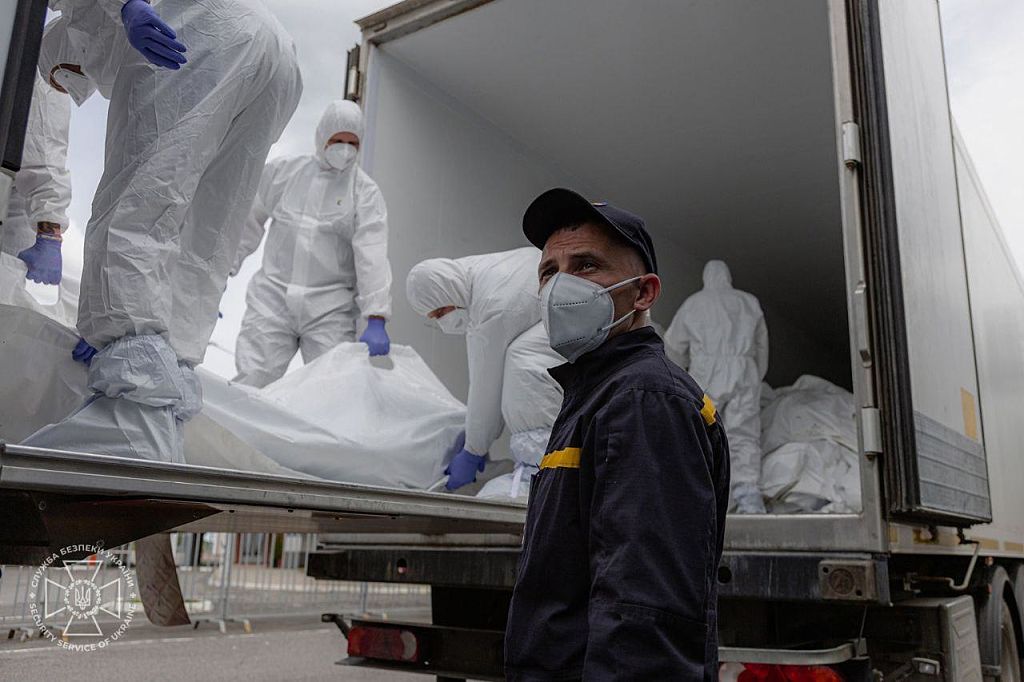
The bodies of Ukrainian servicemen who fought in Kharkiv, Luhansk, Donetsk, Zaporizhzhia, and Kherson regions, as well as in Russia’s Kursk region – where Ukraine launched an incursion in August last year – were returned to Ukraine, as part of the first confirmed swap under a new agreement reached during negotiations in Istanbul last week. (Security Service of Ukraine / Handout/ Anadolu via Getty Images)
Fire in the Powder Keg: Ukraine’s Deep Strike Campaign Intensifies
Ukrainian drones penetrated hundreds of kilometers into Russian territory overnight, igniting the Tambov Gunpowder Plant and striking ammunition depots in a coordinated assault designed to cripple Moscow’s military production. The Tambov facility—one of Russia’s primary manufacturers of gunpowder for small arms, artillery, and rocket systems—erupted in flames as Ukrainian forces demonstrated their expanding capacity to hit strategic targets deep in the enemy rear.
The General Staff described the attack as part of a broader campaign to degrade Russia’s explosive production capabilities. Local residents reported massive explosions followed by towering flames that illuminated the night sky. The plant, a subsidiary of Russian state defense conglomerate Rostec, supplies critical materials for the Russian military’s ammunition needs.
Beyond Tambov, Ukrainian drones struck the ammunition depot of Russia’s 106th Airborne Division in Kursk Oblast and hit the weapons storage facility at Buturlinovka airfield in Voronezh Oblast. The coordinated assault across three regions demonstrated Ukraine’s growing ability to project force across vast distances despite Russian air defenses.
The Tambov plant has faced repeated Ukrainian strikes since November 2023, when U.S. sanctions first targeted the facility. Located southeast of Moscow and hundreds of kilometers from Ukraine’s border, the successful strike showcased the evolution of Ukrainian long-range capabilities and intelligence networks operating inside Russia.
Russian officials acknowledged drone attacks but downplayed the damage, with Tambov Governor Maxim Egorov claiming fires had been extinguished without casualties. The pattern of official denials followed previous Ukrainian strikes that caused significant damage to Russian military infrastructure.
Spiderweb Secrets: SBU Reveals the Anatomy of Strategic Deception
The Security Service of Ukraine released unprecedented footage detailing Operation Spiderweb, the June 1 drone assault that damaged 41 Russian aircraft across four air bases. The video revealed the meticulous 18-month planning process that enabled Ukrainian forces to position 117 drones thousands of kilometers inside Russian territory.
Trucks carrying wooden cabins transported first-person-view drones across Russia, with preparations taking place in Chelyabinsk near a Federal Security Service office. The audacious operation saw loaded vehicles drive to multiple locations across Ivanovo, Ryazan, Murmansk, Irkutsk, and Amur regions before remotely opening their concealed payloads.
The cabins opened on command, releasing drones that struck Russian strategic bombers at Belaya, Olenya, Dyagilevo, and Ivanovo air bases. Only the planned strike on Ukrainka air base in Amur Oblast failed to reach its target. The operation demonstrated unprecedented penetration of Russian security apparatus and territorial control.
SBU chief Vasyl Maliuk, who personally oversaw the operation, emphasized that Ukrainian forces targeted “absolutely legitimate targets—military airfields and aircraft that attack our peaceful cities.” The drones used specialized designs allowing remote control across thousands of kilometers while bypassing Russian electronic warfare defenses.
“The SBU is hitting and will hit Russia where it considers itself unreachable,” Maliuk declared, adding ominously: “We are working on new surprises, no less painful than Operation Spiderweb.” The threat suggested ongoing Ukrainian preparations for additional deep-strike operations against Russian strategic assets.
NATO Admiral Pierre Vandier called the operation a reinvention of “the Trojan Horse” method with “technical and industrial creativity.” Western intelligence estimates placed between 10-13 Russian aircraft as completely destroyed, with President Zelensky claiming roughly half of the 41 targeted planes suffered irreparable damage.
America’s Retreat: Pentagon Confirms Aid Cuts Amid Republican Revolt
Defense Secretary Pete Hegseth confirmed that the Pentagon would reduce funding for Ukrainian military assistance in its 2026 budget, marking a fundamental shift in American commitment under the Trump administration. “This administration takes a very different view of that conflict,” Hegseth told lawmakers while facing fierce criticism from Republican senators.
Senate Minority Leader Mitch McConnell led the revolt, warning that “America’s reputation is on the line” and demanding clarity on whether the United States would continue defending democratic allies against authoritarian aggressors. When pressed on who the aggressor was in Ukraine, Hegseth acknowledged “Russia is the aggressor” but refused to state which side America wanted to win.
“We don’t want a headline at the end of this conflict that says ‘Russia Wins and America Loses,'” McConnell declared, contrasting his Reagan-era commitment to global leadership with Trump’s “America First” approach. The exchange revealed deep divisions within the Republican Party over foreign policy direction and alliance commitments.
Senator Lindsey Graham challenged Hegseth’s assertion that Putin’s future territorial ambitions “remain to be seen,” responding sharply: “This is the ’30s all over. It doesn’t remain to be seen.” The South Carolina senator warned that “Russia will dismember Ukraine and keep going if we don’t stop them.”
The funding reduction follows Trump’s earlier diversion of 20,000 anti-drone missiles originally intended for Ukraine to American forces in the Middle East. Ukrainian President Zelensky confirmed the reallocation, noting that “We were counting on these 20,000 missiles” for defense against nightly Russian Shahed drone attacks.
Hegseth became the first U.S. defense chief to skip a Ukraine Defense Contact Group meeting since the invasion began, signaling diminished American engagement. The administration has halted approval of new military aid packages while demanding Ukraine make territorial concessions to Russia for peace.
Kharkiv’s Night of Terror: Children Among the Casualties
Russian forces unleashed 17 drone strikes against Kharkiv overnight, killing three civilians and wounding 64 others including nine children in a methodical assault on residential areas. The attack struck five-story buildings in Slobidskyi district, leaving 15 apartments in flames while targeting homes, playgrounds, and civilian infrastructure across the northeastern city.
Among the hospitalized were a 2-year-old girl and a 15-year-old boy, testament to Russia’s deliberate targeting of the most vulnerable populations. Regional Governor Oleh Syniehubov reported that Russian forces also hit a trolleybus depot, vehicles, and local businesses in a systematic campaign of terror against civilian areas.
The casualties mounted throughout the day as rescue workers pulled victims from the rubble. A 65-year-old man died from extensive burns in the hospital’s intensive care unit, followed by the deaths of a 66-year-old man and a 47-year-old woman. Later, a 59-year-old woman succumbed to her injuries alongside her husband who had also perished in the morning.
President Zelensky condemned the “brutal strike” that hit “ordinary residential buildings,” emphasizing that rescue operations continued while fires raged across the city. “Every new day brings another vile Russian strike, and almost every strike is a deliberate demonstration,” he wrote, calling for increased pressure on Moscow.
The Kharkiv Regional Prosecutor’s Office launched war crimes investigations under Article 438 of Ukraine’s Criminal Code. The assault represented the latest in a series of intensifying Russian attacks on the city, which sits vulnerable near the front lines and has suffered repeated bombardment throughout the war.
The attack followed Tuesday’s mass Russian assault that killed at least three people and damaged St. Sophia Cathedral in Kyiv. Russian forces continue escalating their civilian targeting despite ongoing peace negotiations and international condemnation.
Sacred Stones Scarred: Restoring Ukraine’s Spiritual Heart
Restoration work began on Kyiv’s UNESCO-listed St. Sophia Cathedral after Tuesday’s Russian attack damaged the 11th-century Orthodox shrine that symbolizes Ukrainian statehood and cultural identity. The white-walled cathedral with green cupolas, built during the Kievan Rus period, suffered facade damage from blast waves that struck the heart of Ukraine’s capital.
“Even St. Sophia Cathedral in the capital was damaged, part of the cathedral’s facade collapsed due to the blast wave,” Zelensky said, calling any threat to the ancient structure “absolutely unacceptable, catastrophic” for those who understand history and Christianity. Culture Minister Mykola Tochytskyi described the cathedral as “the soul of Ukraine.”
Deputy director Vadym Kyrylenko revealed this marked the first direct hit on the shrine since World War II. “Over the past three years of war, we have found the remains of Shaheds on our premises, but the last direct hit we had was during World War II,” he told reporters while specialists developed restoration recommendations.
The cathedral represents “the beginnings of the modern state of Ukraine,” Kyrylenko explained. “This is where it all began. This is the heart of our state.” An 18-year-old art student drawing the cathedral expressed sadness over the damage, noting how the attack on monuments demonstrated “how inhumane this war is.”
The blast wave damaged a cornice of the cathedral’s central apse, requiring careful restoration work to preserve the architectural integrity of one of Eastern Europe’s most significant religious monuments. The cathedral has survived Mongol invasions, Stalin’s purges, and Nazi occupation, only to face damage from Putin’s missiles.
Bodies Come Home: 1,212 Fallen Defenders Return
Ukraine repatriated the bodies of 1,212 fallen service members under agreements reached during Istanbul talks, bringing home defenders who died across multiple front-line regions including soldiers who fought in Russia’s Kursk Oblast. The Coordination Headquarters emphasized the coordinated effort involving security services, armed forces, and international organizations.
The returned remains came from Kharkiv, Luhansk, Donetsk, Zaporizhzhia, Kherson, and Sumy oblasts, representing the geographic scope of Russia’s aggression across Ukrainian territory. Officials stressed that investigative and forensic teams would work to identify the bodies in the shortest possible time.
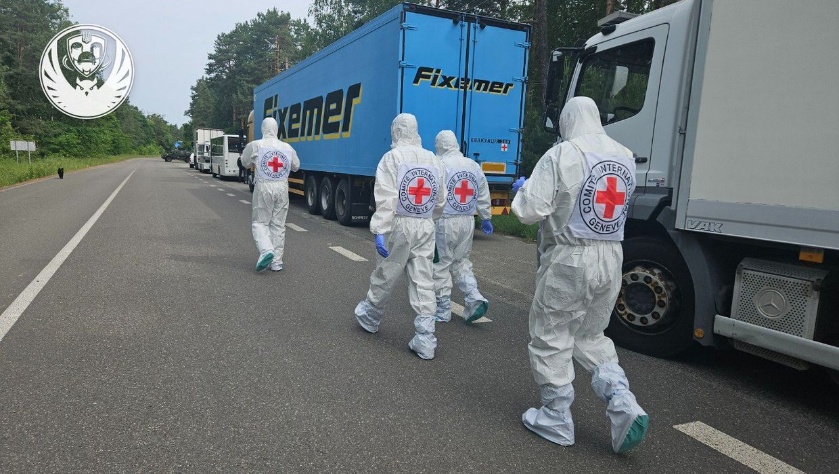
Personnel from the International Committee of the Red Cross take part in a body repatriation operation along a highway in Ukraine. (Coordination Headquarters for the Treatment of Prisoners of War / Telegram)
Vladimir Medinsky, aide to Russian President Putin, claimed Russia transferred 1,212 Ukrainian bodies while receiving 27 Russian remains in return. The disproportionate numbers reflected the scale of Russian casualties in the conflict and Moscow’s reluctance to acknowledge the full extent of its losses.
The repatriation followed the June 2 Istanbul talks that produced the only tangible progress from negotiations otherwise deadlocked on Russia’s maximalist territorial demands. The exchange represented the second phase of humanitarian agreements that included prisoner swaps and commitments to return abducted children.
Ukraine has conducted regular body exchanges throughout the war, with previous transfers involving hundreds of fallen defenders. Unlike Ukraine, Russia does not publicly report the return of its soldiers’ remains and has not updated official casualty figures since claiming fewer than 6,000 deaths in fall 2022.
Economic Warfare: Zelensky Demands Harsher EU Sanctions
President Zelensky called for stronger EU sanctions against Russia at the Ukraine-Southeast Europe Summit in Odesa, arguing that financial pressure remains crucial to forcing Moscow toward genuine peace negotiations. Speaking to southeastern European leaders, Zelensky criticized the proposed 18th sanctions package as insufficient for changing Russian calculations.
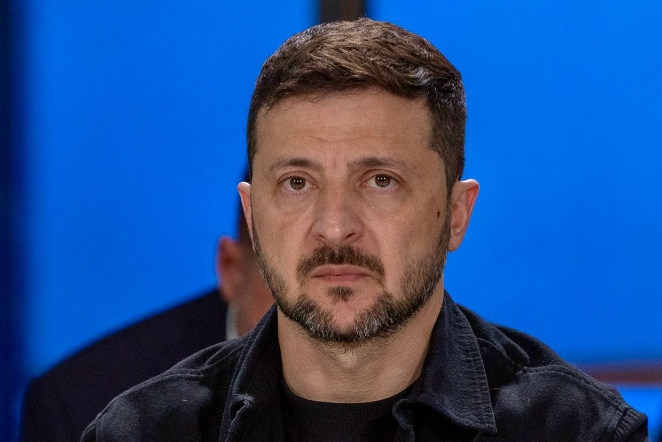
President Volodymyr Zelensky takes part in a meeting as part of the Ukraine-Southeast Europe Summit in Odesa. (Oleksandr Gimanov / AFP)
“A ceiling of $45 per barrel of oil is better than $60, that’s clear, that’s true. But real peace will come with a ceiling of $30,” Zelensky declared. “That’s the level that will really change the mindset in Moscow.” The president’s demands went beyond EU proposals to slash the Russian oil price cap from $60 to $45 per barrel.
The push for tighter economic pressure came as Russia’s budget faced increasing strain from soaring military expenditures while continuing to reject ceasefire proposals. Zelensky warned that Odesa remained one of Russia’s “main targets” with plans to advance toward Romanian and Moldovan borders.
“Russia wants to destroy it, as it has done with countless cities and villages in the occupied territories,” Zelensky said of Odesa. “Russian military plans point to this region and then to the border with Moldova and Romania.” The warning suggested Russian ambitions extended beyond Ukrainian territory.
The Odesa summit included Serbian President Aleksandar Vucic’s first official visit to Ukraine since the invasion began, marking a significant diplomatic moment. Vucic offered Serbian assistance in rebuilding Ukrainian cities while reaffirming support for territorial integrity under international law.
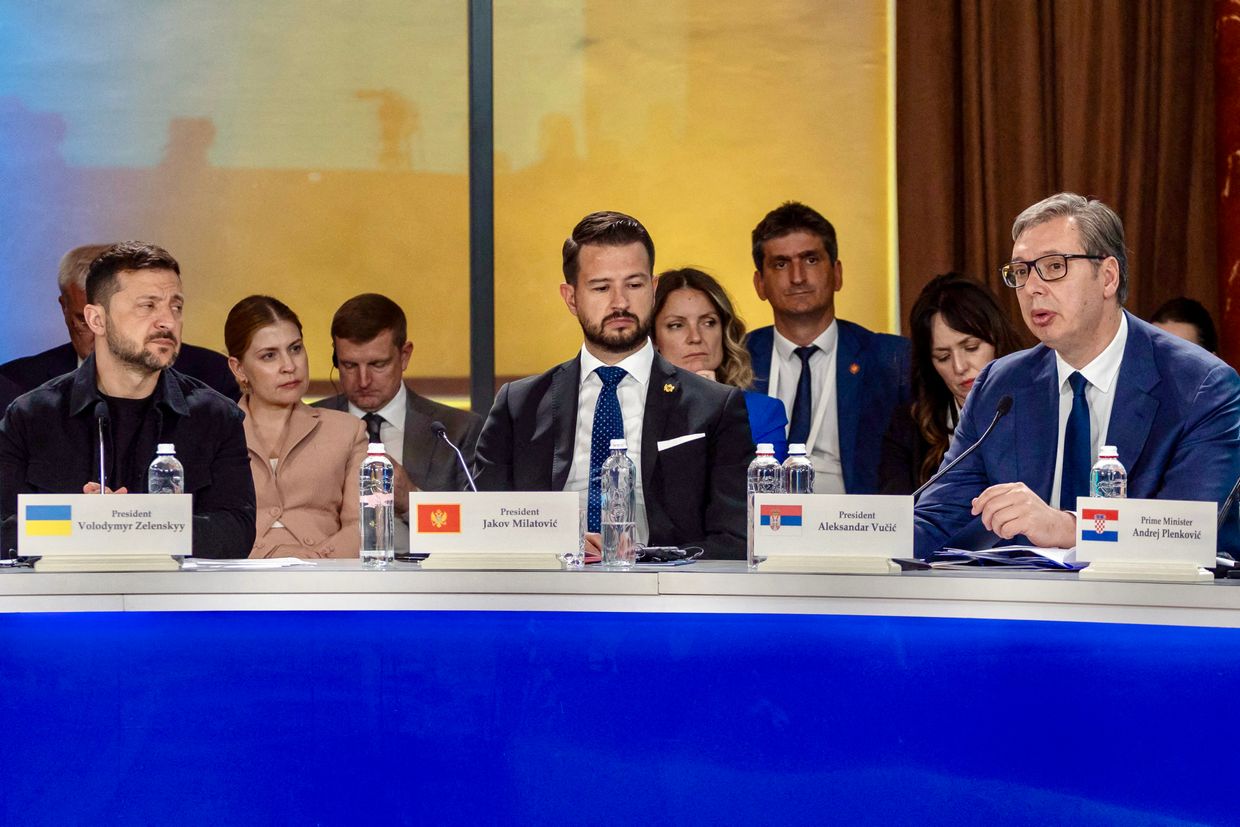
President Volodymyr Zelensky (L), Montenegro’s President Jakov Milatovic (С), and Serbia’s president Aleksandar Vucic during a meeting as part of the Ukraine-Southeast Europe Summit in Odesa. (Oleksandr Gimanov / AFP)
Britain’s Air Defense Boost: £1.7 Billion for Ukrainian Skies
Ukraine will receive nearly £1.7 billion ($2.26 billion) from the United Kingdom to purchase Rapid Ranger air defense systems and Martlet lightweight missiles, Prime Minister Denys Shmyhal announced. The funding represents a “significant strengthening” of Ukraine’s air defense capacity amid intensifying Russian aerial assaults.
Rapid Ranger mobile laser-guided systems offer rapid deployment capabilities effective against low-flying threats including drones and helicopters. The systems typically pair with Martlet missiles designed specifically for drone defense and light aircraft interception.
“This month, the U.K. also announced record aid for the supply of drones. We are talking about 350 million pounds ($473 million), which will allow 100,000 drones to be transferred to Ukraine this year,” Shmyhal wrote, highlighting London’s comprehensive military support package.
The announcement followed Russia’s massive June 10 aerial attack on Kyiv and the previous night’s record assault involving 479 intercepted Russian weapons. The timing demonstrated urgent Ukrainian needs for enhanced air defense capabilities against escalating Russian strikes.
Britain’s 2025 allocation totals £4.5 billion ($5.8 billion) for Ukrainian military assistance, marking London’s largest annual commitment. The U.K. remains among Kyiv’s most steadfast partners, providing long-range missiles, armored vehicles, training, and consistent political support.
Kremlin’s Rhetorical Warfare: Denying Ukrainian Identity and Legitimacy
Russian officials intensified propaganda campaigns denying Ukrainian independence and legitimacy while threatening escalation against Western supporters. Presidential aide Vladimir Medinsky told the Wall Street Journal that the Ukraine war represents “a conflict between two brothers” sharing language and culture.
Medinsky’s statements reflected broader Kremlin narratives attempting to portray Ukraine as lacking independent identity from Russia—rhetoric supporting Moscow’s goals of complete Ukrainian capitulation and pro-Russian puppet government installation. State Duma Chairperson Vyacheslav Volodin falsely claimed President Zelensky’s illegitimacy while recognizing only parliament.
The constitutional framework bars Ukrainian elections during martial law, which cannot be lifted while Russia continues attacking Ukrainian territory. Russian rhetoric aimed to set conditions for withdrawing from future peace agreements while demanding regime change in Kyiv.
Deputy Foreign Minister Sergei Ryabkov blamed European states as “the main obstacle to peace” while accusing them of pushing Ukraine toward continued military operations. Russian officials systematically blamed Western military aid for prolonging conflict while threatening escalation.
State Duma Defense Committee deputy Alexei Zhuravlev called for Russia to strike Ukraine with another Oreshnik intermediate-range missile, implying imminent deployment. The escalatory rhetoric aimed to intimidate Western partners into reducing Ukrainian support while preparing Russian society for expanded conflict.
NATO Summit Uncertainty: Ukraine’s Path Obscured by American Ambivalence
A leaked draft of the upcoming NATO summit declaration omits Ukraine’s membership aspirations and last year’s $40 billion aid pledge, Bloomberg reported, signaling diminished focus on the war for the first time since 2022. The unusually brief document recognizes Russia as a threat but not as an aggressor in Ukraine.
The one-page draft avoids mentioning China despite previous communiques naming Beijing as a “decisive enabler” of Russian aggression. Last year’s Washington summit declared Ukraine’s NATO path “irreversible” while promising substantial military aid commitments.
This year’s document focuses solely on defense spending as President Trump pushes NATO partners to increase military expenditure from 2% to 5% of GDP. The brevity reflects efforts to avoid conflict between Trump and European allies over Ukrainian support levels.
NATO allies will pledge at least 3.5% of GDP for defense needs and 1.5% for infrastructure protection by 2032, with potential inclusion of Ukrainian contributions in new spending targets. The summit’s reduced scope demonstrated American disengagement from Ukrainian cause.
President Zelensky confirmed his invitation to the June 24-25 summit in The Hague despite earlier speculation about U.S. opposition. NATO Secretary General Mark Rutte maintained that Ukraine’s “irreversible path” into the alliance remains unchanged regardless of summit language.
Russian Military Restructuring: Africa Corps Transitions and Infrastructure Protection
The Wagner Group announced its departure from Mali after 3.5 years as Russia’s Ministry of Defense intensifies efforts to replace remaining Wagner personnel with state-controlled Africa Corps. Russian billionaire Gennady Timchenko reportedly finances and oversees the Africa Corps despite official Defense Ministry control.
The insider source characterized Africa Corps as Timchenko’s “personal army” commanded by former convict Konstantin Mirzayants, who successfully pushed out GRU Lieutenant General Andrei Averyanov from leadership. The arrangement contradicted centralization efforts while potentially repeating mistakes that led to Wagner’s June 2023 mutiny.
Russian National Guard (Rosgvardia) planned to bolster infrastructure security against Ukrainian drones by arming Federal State Unitary Enterprise “Okhrana” units with anti-drone weapons. The proposed order included additional ammunition and combat small arms to enhance drone interception capabilities.
The Russian government announced establishing an Artificial Intelligence Development Center to systematize AI implementation across government agencies and businesses. Deputy Prime Minister Dmitry Grigorenko would oversee coordination efforts while imposing legal restrictions on AI developers.
Russia expanded long-range drone production to 170 Shahed drones and decoys daily, with monthly output exceeding 5,000 long-range drones including 2,700 Shahed-136/Geran-2 units and 2,500 Gerbera decoys. The production surge supported sustained strike campaigns against Ukrainian cities.
Putin’s Nuclear Posturing and Ground Force Priorities
Russian President Putin claimed Moscow possesses the world’s most advanced nuclear systems while demanding significant ground force strengthening. Putin stated that Russia’s nuclear triad maintains 95% modern equipment—allegedly the highest among nuclear powers globally.
“Currently, the share of modern weapons and equipment in the strategic nuclear forces is already 95%. This is a good indicator, in fact, it is the highest of all nuclear powers in the world,” Putin claimed while calling for rapid ground force improvements.
“The dominant force in conducting modern military operations of any scale and intensity remains the ground forces. And it is important to increase their combat capabilities in the shortest possible time,” Putin declared, emphasizing conventional warfare priorities.
Deputy Foreign Minister Ryabkov dismissed concerns about Ukrainian drone strikes on Russian airfields affecting nuclear deterrence capabilities. “Our nuclear deterrence potential against the U.S. and any other potential adversary has not suffered significant damage,” Ryabkov claimed.
The statements followed Operation Spiderweb’s demonstrated ability to penetrate deep into Russian territory and strike strategic aviation assets. Russian denials suggested sensitivity about perceived vulnerabilities in homeland defense systems.
Ground Commander’s Departure: Reforms Amid Tragedy
Ground Forces Commander Mykhailo Drapatyi concluded his six-month tenure following the deadly Russian missile strike that killed 12 Ukrainian soldiers at a training camp in Dnipropetrovsk Oblast. Drapatyi submitted his resignation taking responsibility for the young recruits who “should have learned, lived, and fought—not died.”
President Zelensky appointed Drapatyi as Joint Forces commander, shifting his role to focus “exclusively on combat issues.” Drapatyi described inheriting Ground Forces mired in “managerial stagnation” defined by fear, lack of initiative, and frontline detachment.
“Systemic abuse, personnel decisions based on connections, low internal organization,” Drapatyi wrote while noting gradual cultural shifts “from a culture of fear to a culture of responsibility.” He replaced over half of Ground Forces leadership in key functions.
Under Drapatyi’s leadership, the military launched recruitment center reforms aimed at eliminating corruption and increasing mobilization transparency. New leadership was introduced in drone, cyber, and electronic warfare units amid broader modernization efforts.
“Decisions are made not on the basis of status or loyalty, but on the basis of analysis, results, and respect for subordinates,” Drapatyi explained. “Grassroots initiatives ceased to be a threat and began to become a resource.”
Diplomatic Maneuvers: U.S.-Russia Talks and Regional Summits
Russian Ambassador Alexander Darchiev confirmed that U.S. and Russian delegations would hold talks in Moscow in the near future, following previous discussions on peace efforts and bilateral relations. The meetings represented ongoing diplomatic engagement despite military escalation.
The first talks since the invasion occurred February 18 in Riyadh, focusing on bilateral relations, potential presidential meetings, and ending the war. Subsequent rounds addressed diplomatic mission operations and movement of diplomats between the two countries.
The State Department described April 10 Istanbul talks as having a “constructive approach,” with six-hour closed-door consultations focusing on banking services for diplomatic missions. Both delegations exchanged notes and agreed to continue discussions in respective capitals.
Darchiev stated Russia aimed for “non-confrontational coexistence” with the United States while confirming negotiations on returning confiscated Russian diplomatic property. The diplomatic track continued amid Trump’s efforts to broker ceasefire agreements.
Serbian President Vucic’s historic visit to Odesa marked his first official trip to Ukraine, offering Serbian assistance in rebuilding Ukrainian cities while maintaining neutrality between EU aspirations and Russian relationships.
Beijing’s Drone Pipeline: Chinese Components Fuel Russian War Machine
Ukrainian intelligence exposed the deepening scope of Chinese assistance to Russia’s military production, revealing how Beijing’s manufacturers provide critical components enabling Moscow’s expanding drone capabilities. Foreign Intelligence Service spokesperson Oleh Aleksandrov told Politico that Chinese companies supply hardware, electronics, navigation systems, engines, microcircuits, and control boards to Russian developers.
Chinese manufacturers evade sanctions through shell companies and name changes while providing Russia with critical dependencies for tactical and long-range drone production. Russia boosted long-range drone output from 15,000 units in 2024 to over 30,000 in 2025, with small tactical drone production reaching two million annually.
The cooperation extended to artificial intelligence integration, with Russian V2U strike drones using Chinese Leetop A203 minicomputers and American NVIDIA Jetson processors. These AI-enabled drones autonomously search and select targets while navigating through computer vision rather than GPS to counter Ukrainian electronic warfare.
Chinese-made fiber-optic coils enable Russian forces to fly drones at extended ranges up to 50 kilometers, with the equipment weighing just 3.8 kilograms. Russian forces increasingly deploy these immune-to-jamming systems, particularly in the Toretsk-Kostyantynivka direction.
President Zelensky implied that China restricted Ukrainian and European drone procurement while imposing no similar limitations on Russia. The revelations highlighted Beijing’s role as enabler of Russian aggression despite official neutrality claims.
Forced Recruitment: Russia’s Mobilization of Occupied Territories
Russian opposition media revealed that Moscow recruited and mobilized over 73,000 men from occupied Donetsk and Luhansk oblasts as of early 2023, using coercion and financial incentives to expand combat manpower. The Vazhnye Istorii outlet estimated 48,900 people from Donetsk Oblast and 24,100 from Luhansk Oblast based on leaked deserter databases.
The Russian Ministry of Defense continued targeting Ukrainian men in occupied territories through military training centers and threats against students with loan debt. Officials in occupied Luhansk planned to train 300 young people in military-political specialties in 2025, expanding to 700 by 2027.
Occupation authorities decreased one-time military contract payments in Donetsk Oblast from 800,000 rubles ($10,194) to 400,000 rubles ($5,097) while maintaining higher payments in Kherson Oblast. The financial incentives aimed to offset resistance to forced recruitment.
Russian occupation officials threatened to expel Ukrainian students with debt unless they signed military contracts, while simultaneously offering enlistment bonuses to overcome reluctance. The systematic coercion violated international laws governing occupation behavior.
Ukrainian intelligence previously estimated 60,000 recruits from occupied territories, while Russian General Staff reported mobilizing 79,800 people from Donetsk and Luhansk oblasts. The real numbers likely exceeded official figures due to incomplete documentation of early recruits.
Opposition Crushed: Navalny Ally Sentenced to 18 Years
A Moscow military court sentenced Leonid Volkov, close associate of late opposition leader Alexei Navalny, to 18 years in maximum security prison in absentia. The ruling represented the Kremlin’s continued crackdown on domestic opposition since launching its full-scale war against Ukraine.
Volkov faced 45 cases under nine criminal articles ranging from “discrediting” the military to alleged ties with “extremist groups” and “rehabilitation of Nazism.” The charges reflected standard accusations used to suppress political dissent and silence opposition voices throughout Russia.
The court ordered Volkov to pay 2 million rubles ($25,000) in fines while banning him from online activity. Volkov served as Navalny’s chief of staff during the 2018 presidential campaign and led the Anti-Corruption Foundation until 2023.
Volkov suffered injuries in a March 2024 assault at his Lithuanian home, with Polish authorities later detaining a Belarusian suspected of organizing the attack on Moscow’s behalf. The incident demonstrated the Kremlin’s willingness to pursue opposition figures across international borders.
The sentencing occurred as Russian authorities intensified persecution of anti-war activists and civil society organizations. Navalny died in Russian prison custody in February 2024 under unclear circumstances, removing the most prominent opposition leader.
Historical Reconciliation: Poland-Ukraine Exhumation Progress
Ukraine granted Poland permission to conduct exhumation work on remains of Polish soldiers killed in 1939 and buried near Lviv, marking renewed cooperation on sensitive historical issues. The decision followed years of tension surrounding war memorials and historical sites between the two countries.
The Culture Ministry described the move as a further step in Polish-Ukrainian cooperation through the Joint Working Group on historical matters. Ukraine imposed a moratorium on exhumations in 2017 after Ukrainian Insurgent Army monuments were destroyed in Poland.
The Zboiska site contains remains of approximately 120 Polish soldiers who died fighting Nazi German forces in 1939, with bodies first located in 2019. The Institute of National Remembrance submitted formal requests to excavate burial grounds in Zboiska and Pid Holoskom districts.
The cooperation follows successful April exhumations in Ternopil Oblast’s former village of Puzhnyky, associated with 1945 killings of Polish civilians during the Volyn massacres. Ukraine received Poland’s approval for reciprocal exhumation activities in Polish village of Yurechkova.
Polish Prime Minister Donald Tusk called the agreements a “breakthrough” while warning that unresolved historical issues could influence Ukraine’s EU and NATO aspirations. The progress reflected both countries’ commitment to historical truth and European integration.
Putin’s Daughter Scandal: Anti-War Gallery Employs Kremlin Princess
Russian artist Nastya Rodionova exposed that Luiza Rozova, widely alleged to be Vladimir Putin’s daughter, works at Paris galleries showcasing Russian and Ukrainian anti-war art. The revelation sparked controversy within emigre communities about transparency and security risks for opposition artists.
Rozova, whose mother Svetlana Krivonogikh possesses over $100 million in assets and faces UK sanctions, bears “uncanny resemblance” to Putin according to investigative outlets. She works at Studio Albatros and L Galerie, which exhibit works by Russian and Ukrainian artists fleeing the regime.
“We are talking about artists who fled the regime,” Rodionova explained. “Many of them are in danger. They shared all their personal information with gallery staff without knowing who works there.” The security concerns reflected potential risks of regime connections.
Gallery director Dmitri Dolinski confirmed Rozova’s maternal connections while claiming he doesn’t investigate employees’ families. However, he hired Rozova knowing her mother’s sanctions status and wealth sources linked to Russian regime operations.
The L Association defended Rozova against “collective punishment,” arguing no one should be judged by origins beyond their control. However, critics emphasized the need for transparency when dealing with regime-connected individuals in anti-war spaces.
Energy Resilience: EU-Germany Boost Ukraine’s Efficiency Fund
The European Union and Germany topped up Ukraine’s Energy Efficiency Fund with €18 million ($20.7 million) to expand support for energy independence and green recovery. The EU provided €13 million while Germany’s International Climate Initiative contributed €5 million.
The fund operates through VidnovyDIM and EnergoDIM programs, helping repair war-damaged homes and co-financing grants for energy consumption reduction through insulation, windows, and heating system improvements. Since 2021, the fund grew from 90 to 1,500 projects while saving 300 kilowatt-hours in energy consumption.
The EEF has assisted over 217,000 families in modernizing and repairing homes, with half covered by war damage repairs. The new financing will increase grant limits to over €200,000 while resuming applications paused due to high demand.
Around 10% of Ukraine’s housing stock has been damaged or destroyed while much of the heating system remains Soviet-era and inefficient. Russian attacks on energy infrastructure have caused widespread instability while increasing electricity and heating costs for citizens.
The fund helps buildings become more energy efficient, cutting costs and retaining warmth during blackouts. First Deputy Minister Alena Shkrum noted that Russian attacks are increasing Ukrainian understanding of energy efficiency importance.
Baltic Tensions: Russian Naval Exercises Escalate Regional Pressures
Russian forces continued major naval exercises in the Baltic Sea involving over 20 warships and 25 aircraft, likely supporting the Kremlin’s escalatory rhetoric against Baltic States. The exercises included four Kalibr cruise missile carriers and the Admiral Flota Kasatov frigate carrying Zircon hypersonic missiles.
Russian forces practiced using Bal and Bastion coastal missile systems while performing deployment tasks and electronic missile launches against mock enemy vessels. The exercises focused on improving Navy-Air Force interoperability in navigation, ship seizure prevention, and defensive operations.
The Baltic Fleet, Northern Fleet, and Aerospace Forces participated in training involving 3,000 servicemen and 70 pieces of military equipment. Russian forces also conducted anti-terrorist naval drills as part of the comprehensive exercise program.
The exercises began May 27 amid intensified Kremlin rhetoric against Baltic countries and broader NATO expansion concerns. Russian officials have escalated threats against Eastern European allies while demanding legally binding guarantees against further alliance growth.
The timing coincided with Russian demands for NATO to reduce contingent sizes in Eastern Europe while threatening consequences for continued Western military support to Ukraine. The exercises demonstrated Russian capabilities for potential Baltic Sea conflicts.
The events of June 11 demonstrated the expanding scope and intensity of the Ukraine conflict as both sides escalated their military operations. Ukrainian forces proved their ability to strike deep into Russian territory while maintaining tactical gains across multiple front sectors. The successful targeting of ammunition production facilities threatened Russia’s ability to sustain its artillery-intensive warfare.
Meanwhile, Russia’s response took its familiar form: deliberate targeting of Ukrainian civilians, particularly children, in systematic terror campaigns designed to break Ukrainian resistance. The death of nine children in Kharkiv alone over two days revealed Moscow’s calculation that terrorizing families would prove more effective than military victories.
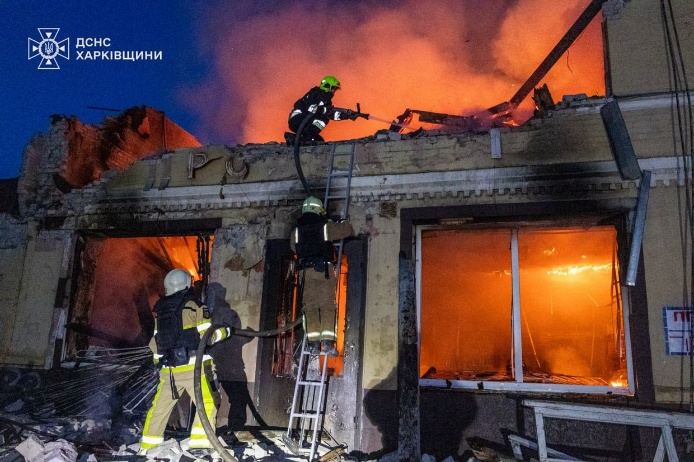
Firefighters extinguish a fire following a Russian drone attack on Kharkiv overnight. (State Emergency Service / Telegram)
America’s retreat from Ukrainian support created dangerous precedents for global security while emboldening authoritarian aggression worldwide. Republican senators’ revolt against the Trump administration’s policies suggested growing recognition that abandoning Ukraine would invite further Russian expansion and Chinese adventurism.
The contrast between Ukrainian innovation and Russian brutality became starker with each passing day. While Ukrainian forces developed sophisticated deep-strike capabilities and maintained defensive resilience, Russian forces increasingly relied on targeting schools, hospitals, and homes to achieve political objectives.
The gunpowder burning in Tambov symbolized Ukraine’s growing capacity to project power across vast distances and strike at the heart of Russia’s military machine. Yet the blood spilling in Kharkiv reminded the world that Putin’s war remained fundamentally a campaign of terror against civilian populations.
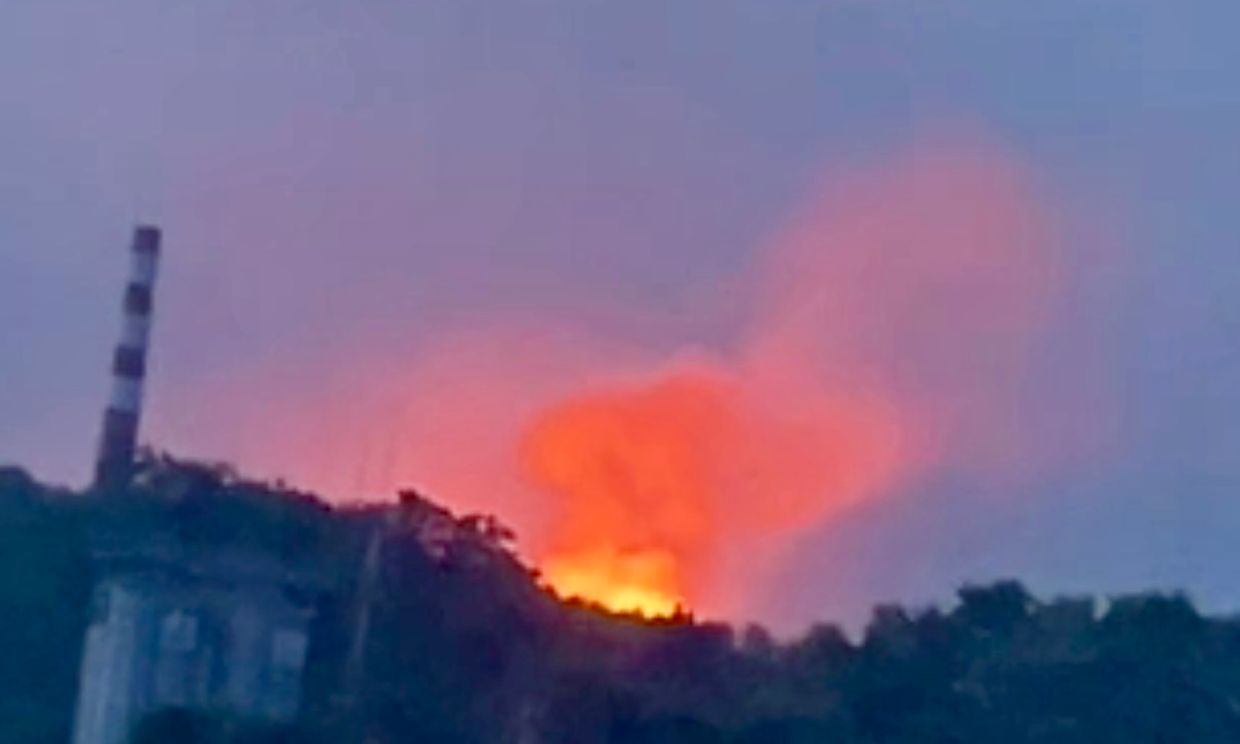
A purported image of a fire at the Tambov Powder Plant in the town of Kotovsk in Russia’s Tambov Oblast overnight. (Astra / Telegram)
As diplomatic efforts continued to founder on Russian maximalism and American ambivalence, the military dynamics suggested a protracted conflict where Ukrainian ingenuity would be tested against Russian mass and Western resolve against authoritarian patience. The children of Kharkiv would continue paying the price for the world’s failure to decisively confront aggression.
